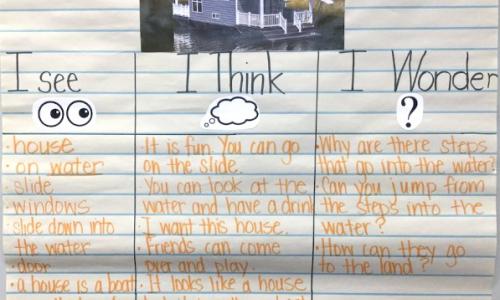
This visible thinking routine developed by Harvard Project Zero launches a unit or text with an image and uses students' observations, inferences, and questions to develop vocabulary and background knowledge before starting a unit. This strategy is part of Colorin Colorado's ELL Strategy Library and can be used to support academic language development for all students.
Strategy Overview
How This Strategy Supports Language Development
Teachers launch a unit with an image and students share what they see or notice in the image. Then they make inferences by stating what they think about the items in the image. Finally, they ask questions about the image.
This routine scaffolds learning by asking students to first carefully notice details in an image. When teachers label these words and phrases on the image, they are building content vocabulary for all students. As students begin stating what they think about the image, they are building background knowledge and developing critical thinking skills. Finally, asking questions about the image stimulates curiosity at the beginning of a unit and teaches students to ask their own questions.
Step-by-Step Instructions
- Project a detailed image that captures the essential concepts for a new unit of study.
- Ask students to carefully observe the photo and notice as many details as they can.
- Have students share their observations with a partner, taking turns saying what they see or notice.
- Randomly call on students to share their observations and chart these on the projected photo on the white board or chart paper.
- Next, ask students what they think might be going on in the picture or what they think about their observations.
- Again, have them share their thinking with a partner, taking turns stating what they think or what they infer about the picture.
- Randomly call on students to share their thinking and chart their inferences.
- Finally, ask students what they wonder about the picture. Again, chart their questions to refer to during the unit.
Lessons Learned
- Selecting an engaging, detailed image is essential.
- Give students a copy of the projected image so they can label their own copy as you label the projected image.
- When first using this routine, chunk the instructions so that students first only focus on what they can observe in the picture. If they jump to making inferences, ask what they noticed in the image that led to that inference.
- Encourage students to first share what they See, Think, and Wonder with a partner before randomly calling on a few students each time. This lowers the affective filter and encourages more participation.
- Chart students' thinking on the projected image or chart paper. This chart is one way students begin to build vocabulary and background for the unit.
- Once students have learned the routine, they may be able to do the entire process of See-Think-Wonder with their partner without stopping at each stage.
- Student interaction for each phase of the routine is important for multilingual learners.
Differentiation
Entering/Emerging
- Provide students with sentence frames for expressing what they think or infer and question starters for generating questions.
- Encourage students to say whatever words they know in the picture including colors, numbers, food items, etc.
- Partner students with a student who speaks the same heritage language and whose English proficiency is more advanced.
Developing
- Partner students with peers who speak the same heritage language and at different levels of English proficiency.
- Provide sentence frames for explaining their thinking and question frames for asking deeper level questions.
Expanding:
- Ask students to make inferences based directly on what they see in the picture and their own background knowledge.
- Ask students to explain their thinking and inferences.
Co-Teaching Considerations
Content or Grade-Level Teacher
- Choose the detailed image to launch the unit.
- Determine key vocabulary and concepts students should notice and infer from the visual. Share with the ELD teacher.
English Language Development Teacher
- Purposefully partner students for the activity.
- Provide sentence frames for inferring and question supports for wondering.
- Work with a small group, if necessary.
Examples
| See-Think-Wonder #1 |  |
| See-Think-Wonder #2 |
Credit: See-Think-Wonder: Grade-level and content-area examples from Thinking Pathwayz |
| See-Think-Wonder #3 |
|
Resources
- Visual Thinking Strategies for improved comprehension (Colorín Colorado)
- What’s Going on in this Picture (The New York Times)
- See-Think-Wonder: Grade-level and content-area examples (Thinking Pathwayz)
- Video of See-Think-Wonder (Edutopia)




